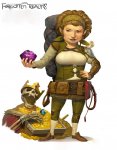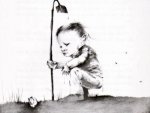You are using an out of date browser. It may not display this or other websites correctly.
You should upgrade or use an alternative browser.
You should upgrade or use an alternative browser.
D&D 5E (2014) Halflings Of The Corn
- Thread starter BigVanVader
- Start date
shadow
First Post
I must be a minority. I actually like the halfling art in 5e. I always hated how halflings were drawn in 3e and 4e. The 3e and 4e halflings were proportioned exactly like humans, so you could never tell if the artwork was supposed to portray humans or halflings except when another character was in the illustration for size reference.
lutecius
Explorer
Sorry, the implementation in the PHB may be worse but the concept art was already awful (enormous heads and ridiculously tiny feet) and many people said as much in the comments at the time. Why WotC kept going with it remains a mystery.What's a little frustrating, is that if you hunt down the articles where the art director talks about Halflings, the concept art isn't so bad.
If that was the goal, they failed because on several pictures the only sure way to tell the gnomes from the halflings is the pointy ears. There was no need to make either race hideous for that.They had a stated goal of designing the races so that one could identify a member of said race in a given picture very easily, which they succeeded in doing. A Gnome is clearly a Gnome, and a Halfling is clearly a Halfling, without any size referents needed.
Not sure why they had to "escape the hobbit chasm" (after so many years of shameless imitation, especially now that there are immensely popular movies far more likely to attract new halfling players than the pictures in the PHB).They're not my favorites but trying to draw a halfling without needing another object to create scale is scale when you can't go heavy on the big or hairy hands and feet thing. Escaping the hobbit or small human chasms could not have been easy.
If it's some brand identity or copyright issue (again, why now?), covering the iconic hairy feet should be more than enough to differentiate them visually. Slightly larger extremities are just a common cue for fantasy little people in illustration, independently of Tolkien.
If you're going with a big head, also having larger hands and feet simply looks more balanced and is less reminiscent of some creepy toddler.
As for "small humans", they aren't my preference but I don't see why a fantasy race couldn't look exactly like a small, well-proportioned human (and thus require another object as a size reference) either. It's a perfectly valid concept in itself.
Last edited:
Blackwarder
Adventurer
I have no problem with 5e halfings, I think that the art is spot on.
Warder
Warder
I must be a minority. I actually like the halfling art in 5e. I always hated how halflings were drawn in 3e and 4e. The 3e and 4e halflings were proportioned exactly like humans, so you could never tell if the artwork was supposed to portray humans or halflings except when another character was in the illustration for size reference.
watch the lord of the rings movies to watch this opinion fall into bitter, silly pieces.
i would rather play something without a cartoon physiology.
aramis erak
Legend
Because people with deformed bodies also have evil minds and souls?
Or are they drawn with wicked grins? (I haven't seen the art in question.)
Ever since Gary Gygax listed four types of Halfling, with the same names Tolkien used (Proudfoot etc.), pretending that D&D halflings aren't LOTR halflings is ludicrous.
It's a requisite legal fiction, however, due to the trademark on the term "Hobbit"... which TSR settled a case about in 1976.
Scorpio616
First Post
Queer Venger
Dungeon Master is my Daddy

It's a requisite legal fiction, however, due to the trademark on the term "Hobbit"... which TSR settled a case about in 1976.
I have a theory that this is the reason why D&D halflings look the way they do, to avoid any similarities with Hobbit, particularly with the Hobbit films coming out and the fact that a new D&D film series is in the works (once Warner Brother's gets rights to it).
I think that is why their hands and in particular, their feet are particularly small and childish, which is ok by me.
Here is another sample I found created by Conceptopolis on Deviant art.
Similar Threads
- Replies
- 49
- Views
- 4K
D&D 5E (2024)
2024 MM - Winners and Losers
- Replies
- 47
- Views
- 6K
- Replies
- 21
- Views
- 4K
- Replies
- 176
- Views
- 42K
Enchanted Trinkets Complete
Recent & Upcoming Releases
-
June 18 2026 -
October 1 2026



